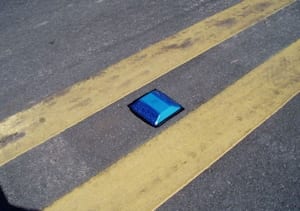 Welcome to Thursday Trivia where we offer up a historical automotive trivia question and you try and solve it before seeing the answer after the jump. It’s like a history test, with cars! This week’s question: What are the blue road reflectors on U.S. roads supposed to signify? If you think you know the answer, make the jump and see if you are right. Earlier this week we talked about the Model T and how that iconic Ford model put the world on the road. Of course back when the Model T was new, most roads outside of cities were nothing more than dirt paths or if you were lucky oiled dirt. As the automobile became more ubiquitous so did the need for safer roads, and those roads needed lane demarcation that would work even in limited visibility conditions.
Welcome to Thursday Trivia where we offer up a historical automotive trivia question and you try and solve it before seeing the answer after the jump. It’s like a history test, with cars! This week’s question: What are the blue road reflectors on U.S. roads supposed to signify? If you think you know the answer, make the jump and see if you are right. Earlier this week we talked about the Model T and how that iconic Ford model put the world on the road. Of course back when the Model T was new, most roads outside of cities were nothing more than dirt paths or if you were lucky oiled dirt. As the automobile became more ubiquitous so did the need for safer roads, and those roads needed lane demarcation that would work even in limited visibility conditions. 
Blue RPMs are designed to catch the eye of emergency vehicle drivers as they indicate the presence of a hydrant on the side of the road. Steven Cole, president of the Reflective Tape Store, notes that blue markers are typically placed at the center of the road or on the side. If the hydrant stands at a corner, then each road might have its own marker. Marcia Lozer, a spokeswoman for 3M Roadway Safety, notes that blue RPMs may also indicate emergency entrances onto roads near firehouses—so they’re something even regular motorists might want to notice.
Blue road reflectors don’t serve the same purpose in much of the EU where they instead indicate the location of police slips from which the po-po can monitor traffic. Other colors can also serve different functions depending on locale. As example, red means wrong way in the U.S. but typically indicates the shoulder in Europe. White reflectors are generally ubiquitous the world round indicating lane divisions. Image: The Slate

